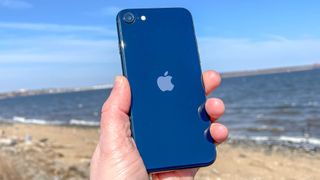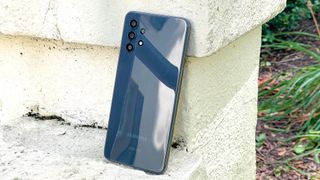
When it comes to picking one of the best cheap phones, you should always look for the features which are most important to you. Not every handset will be able to provide all the bells and whistles offered by top flagship models, however, you will find that most affordable options will still deliver a fairly robust smartphone experience.
A good cheap handset will still provide all the essential functions we’ve come to expect from today’s best phones, such as the ability to make calls, send text messages, browse the internet, take photos and even play games. That said, the price difference can usually be measured by how well it does those things.
While it’s true that budget smartphones have come a long way in the last few years, some may prioritise certain features over others. That means you should expect some trade-offs — you won’t always find the most powerful processors, 120Hz displays or versatile zoom cameras.
That said, you’ll likely be surprised by what today’s more affordable phones are capable of. Below you’ll find a list of the best cheap phones in Australia for 2022. Whether you’re looking for an Android or iOS device, every smartphone on this list is priced under AU$750, which is less than half of what you’d pay for a current flagship phone in 2022. Read on to find out why we’ve chosen these particular models.
The best cheap phones you can buy today
Why you can trust Tom’s Guide
Our expert reviewers spend hours testing and comparing products and services so you can choose the best for you. Find out more about how we test.
If you’re willing to overlook its disappointing battery life, the Google Pixel 6a is hard to beat as the best cheap phone overall. Credit the cameras, which always stand out on Google’s budget devices. Like its predecessors, the Pixel 6a relies on computational photography to deliver some of the best images in this price range — its photos can even challenge those produced by much more expensive phones. And unlike the iPhone SE (its closest competitor on the cheap camera phone front), the Pixel 6a supports a night mode.
You’ll also find a Tensor chipset powering the Pixel 6a. That’s the same silicon inside Google’s Pixel 6 flagships, which start at AU$150 more than the Pixel 6a. As a result, the same AI-powered tricks Google’s flagship phone can pull off are available to the Pixel 6a, too, including the photo-editing Magic Eraser tool and on-device translation.
For AU$749, you get a lot of value with the Pixel 6a. It’s the phone to get if you place a premium on camera capabilities and special features. The biggest question these days is whether to pony up an additional AU$150 to get the affordably priced Pixel 7 that’s powered by a newer Tensor G2 chipset (our Pixel 7 vs. Pixel 6a comparison looks at what’s different besides the price).
But if you really want to stick to that sub-AU$750 budget, the Pixel 6a is the way to go, especially with Pixel 6a deals dropping the price even lower than RRP. In fact, it’s common to see the Pixel 6a discounted by hundreds of dollars — especially if you’re willing to purchase an international model.
Read our full Google Pixel 6a review.
If the Pixel 6a doesn’t sway you, then you may want to give Samsung’s Galaxy A53 a shot. This great mid-range handset is priced at AU$549 for the 128GB model, and can often be found even cheaper than that. It also does just about everything well enough. It has a nice 6.5-inch AMOLED display with a 120Hz refresh rate, supports 5G speeds and has a large 5,000mAh battery (our Pixel 6a vs. Galaxy A53 face-off goes into greater detail on the differences between these best cheap phone contenders for Android fans.)
Of course, the cameras could be better, especially in light of the Pixel 6a. However, they do just fine if you’re okay with Samsung’s characteristic oversaturated look. The performance won’t wow you like the iPhone SE (2022), but it’s good enough for most daily tasks.
Read our full Samsung Galaxy A53 5G review.
The iPhone SE 2022 takes cheap phones to the next level of performance by including Apple’s powerful A15 Bionic chip. This is the same processor found in the iPhone 13, and it blows all Android phones away, whether you’re playing games or editing video on the go.
This chip also gives the new iPhone SE 2022 a number of photography powers that the previous model lacked, including Smart HDR 4, Magic Fusion for better detail and Photographic Styles. In fact, in some scenarios the iPhone SE takes better pics than the Google Pixel 6a, as you can see in our Pixel 6a vs. iPhone SE 2022 face-off. Unfortunately, Apple didn’t include Night mode for low-light situations.
The latest iPhone SE features the same design as before, so that means a small 4.7-inch display and big bezels, but some may prefer the old-school Touch ID button for quickly unlocking the device. Despite some trade-offs, the iPhone SE 2022 is one of the best cheap phones around for people who like small phones, and unlike the rumored iPhone SE 4, it’s available right now. Priced at AU$719, Apple’s cheapest new handset can often be found even cheaper than that.
Read our full iPhone SE 2022 review (opens in new tab).
While Samsung’s Galaxy S20 FE (which stands for ‘Fan Edition’) is a little harder to find since the arrival of its successor, the Galaxy S21 FE, there remains a number of retailers in Australia selling the still-great handset at a significant discount.
As one of the better-value Android phones on the market, the Galaxy S20 FE offers a 120Hz Super AMOLED display, 5G connectivity and a triple camera array with 30x Space Zoom — not bad for a phone that can routinely be found in the AU$600-$700 price range.
Of course, there are a few areas where the S20 FE cuts corners in order to keep the price down, namely its plastic back, its older Gorilla Glass 3 front, and its lower-resolution main camera, but you’ll still get the kind of performance you’d expect from an S-series Samsung handset.
Read our full Samsung Galaxy s20 FE review.
More affordable 5G phones are arriving all the time, but don’t lose sight of the Samsung Galaxy A32 5G. It’s well past its first birthday, but with a sub-AU$500 price, it’s still a great bargain if you’re willing to put up with a mediocre display.
With its big 6.5-inch screen, the A32 is not a small phone. But it packs a 5,000mAh battery that lasts a really long time — almost 12 hours in our testing with its adaptive refresh rate enabled. You can also expect the Galaxy A32 to last longer overall than many other budget options, with Samsung promising three years of Android updates and four years of security patches.
Read our full Samsung Galaxy A32 5G review.
What to look for in the best cheap phones
After you’ve found a phone at the right price for your budget — that’s why you’re considering one of the best cheap phones in the first place, after all — consider what features one of these devices has to offer and which ones you’re sacrificing for a lower price tag. Battery life, the number and types of cameras, display refresh rate and the type of chipset powering the phone are all ways that cheap phones can distinguish themselves.
In some cases, you’ll be able to compare phones to more expensive options to help crystalize what compromises you’re making for a lower-cost model.
Generally, one area in which phone makers cut back for budget models is materials. They’ll use plastic for the phone’s case instead of metal and glass. Cheaper phones may also turn to LCD panels instead of OLED screens, though that’s becoming less frequent among some of the best cheap phones running Android.
One other area to consider is software updates and support. We’ve seen cheaper Android phones either ship with older versions of Android or promise very few upgrades to future versions. Samsung has one of the better upgrade policies with its Galaxy A lineup, and the iPhone remains a standout for usually supporting five years of iOS updates.
How we test the best cheap phones
We evaluate budget-priced phones the same way we do flagships. We perform real-world testing and synthetic benchmarks over several days to evaluate it’s performance and value. This includes our own battery test, which involves continuous web surfing over cellular at 150 nits of screen brightness. The devices that make our best phone battery life list tend to last over 11 hours.
In terms of performance, we use Geekbench 5 to measure overall speed and compare versus phones in the same price range. And the same thing goes for GFXBench for graphics testing. We also perform our own video editing/transcoding testing using the Adobe Premiere Rush app to gauge real-world speed.
For evaluating cameras on cheap phones, we will take multiple photos in different conditions and will use other affordably priced phones in the same scenarios in order to make side-by-side comparisons.
For more information, check out our how we test page for Tom’s Guide.






